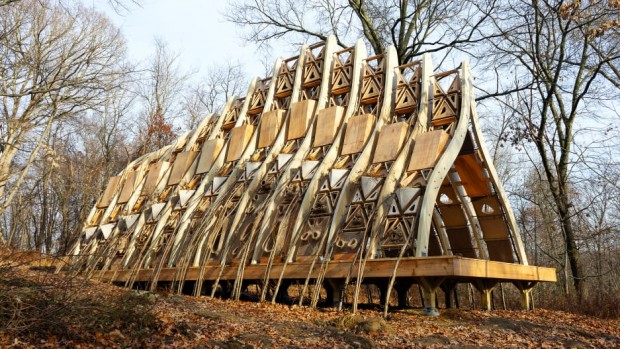The Fab Tree Hub is an ecologically speculative residential design. Thus, Terreform One uses trees growing naturally as part of their project, which also involves utilizing a biomass farm.

(Photo : Fast Company/Mitchell Joachim )
Alive Architecture
A mysterious new skyscraper grows in a Hudson River woodland north of New York City. Humans, animals, and plants have been designed to live in this innovative structure. As mentioned, Fab Tree Hub's construction is slow since it is constructed entirely of trees in the growth process.
Terreform One, led by architect Mitchell Joachim, is a nonprofit art, architecture, and urban design research group. Since 2002, the project's idea has matured like a tree. Habitat for Humanity held a design competition for suburban home innovations. Joachim was a Ph.D. student in architecture at the Ecological Dynamics in Design project.
He and doctoral students Lara Greden and Javier Arbona explored innovative ways natural processes could be used in the design brief of building huge volumes of homes. However, the primary issue is that these structures require an extended development period. As a result, Joachim and his team brainstormed ways to speed up the process. Hydroponic tree growth and scaffold transplantation were their initial experiments, but they failed because they produced weaker trees.
After years of research, the team discovered biomass farms, which grow trees and burn them to generate electricity while researching fast tree growth methods. These farms cultivate dense rows of trees that reach dozens of feet in a few years. The tall, slender trees were an excellent choice for Joachim and his crew's envisioned scaffold. The project changed to replacing white willows from a biomass farm.
Moreover, these trees that have been transplanted are used to construct the Fab Tree Hab pavilion that is currently located in the wild in the state of New York. The trees constitute a few dozen vertical ribs of the pavilion and are planted together in groups. Individual clusters generate building pillars by grafting together into a thicker tree.
About Terreform One's Fab Tree Hab
The Fab Tree Hab is the first building of its kind. It is a reef on land and a forest of grafted living trees. In this multispecies environment, which is shared by both people and animals, native tree-grafting procedures are combined with cross-laminated timber (CLT) arch scaffolds that were created computationally and then removed after the trees have been shaped. This project aims to develop a prototype for a residence that is seamlessly integrated into its natural setting and the substitution of long-lasting, bio-based alternatives for potentially hazardous industrial materials.
Accordingly, the system has the potential to serve as a significant catalyst for the improvement of air quality, the sequestration of carbon, the enhancement of biodiversity, and the provision of refuge and food supplies for local animals. Instead of focusing on efficiency or achieving net zero, this model is a maximal positive contribution model. No trees are being felled to construct a structure. Instead, the architects actively cultivate additional trees entangled in a shaped geometry for programmed application.
The self-healing and environmentally sensitive properties of biological systems are utilized in this project so that they can be implemented in the face of devastating climate calamities. Inspired by the Living Root Bridges of Meghalaya, India, they deliberately used scaffolding and woody plants instead of emissions-heavy concrete, glass, and steel. The computational techniques of manipulating pre-grown biomass were more advanced than those of indigenous ancestors. Particular components are adjustable and can be substituted as their effectiveness is evaluated.
Related Article: Building the Future: The Eco-Friendly Advantages of Modular Home







